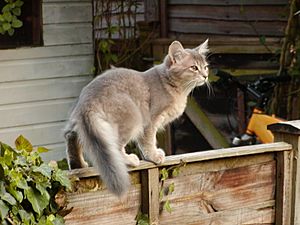Somali cat facts for kids
Quick facts for kids Somali |
|
|---|---|

A blue Somali kitten
|
|
| Common nicknames | Fox cat; long-haired Abyssinian |
| Origin | Somalia |
| Breed standards | |
| CFA | standard |
| FIFe | standard |
| TICA | standard |
| AACE | standard |
| ACF | standard |
| ACFA/CAA | standard |
| CCA-AFC | standard |
| Domestic cat (Felis catus) | |
The Somali cat is a beautiful cat with a long, fluffy coat. Many people think of it as a long-haired version of the Abyssinian cat. It's believed that the Somali cat came from Somalia, a country in Africa. This makes it a distant relative of the Abyssinian cat, which comes from nearby Ethiopia.
Contents
How the Somali Cat Began
Early Discoveries
In the 1940s, a British cat breeder named Janet Robertson sent some Abyssinian kittens to places like Australia and North America. Sometimes, these cats had kittens with longer, fluffier fur than usual. This was a surprise to breeders!
In 1963, a Canadian breeder named Mary Mailing showed one of these long-haired kittens. A judge at the show, Ken McGill, was very interested. He asked for one of these unique kittens to help with breeding.
A New Kind of Cat
The first known long-haired Abyssinian in America was born in 1953. Its name was 'Raby Chuffa of Selene'. Breeders thought that the gene for long hair had been passed down through its family.
Many breeders were shocked by these fluffy kittens. They didn't want to talk about them. But some breeders were curious and kept breeding these long-haired Abyssinians. Other Abyssinian breeders didn't like this new look. They tried to keep the long-haired gene out of their own cats.
Naming the Somali Cat
An American Abyssinian breeder, Evelyn Mague, also had long-haired kittens. She decided to call them "Somalis." Mague looked for other breeders who had similar long-haired Abyssinians. She found many around the world!
Don Richings, another Canadian breeder, started working with Mague. They used kittens from Ken McGill's line. The first Somali officially recognized by a cat club was Mayling Tutsuta, one of McGill's cats.
Becoming Famous
In 1979, the Somali cat breed was officially recognized by the CFA in North America. This was a big step! Europe accepted the new breed in 1982. By 1991, the Somali cat was known and loved by many cat clubs around the world.
The name "Somali" comes from the country Somalia. This country shares a border with Ethiopia, which used to be called Abyssinia. Evelyn Mague thought that if countries could share borders, then these two cat types could also be related.
Mague also started the Somali Cat Club of America. This club helped the breed become a champion cat in the CFA in 1979.
What Somali Cats Look Like
Special Features
Somali cats are known for their fluffy tails, which look a bit like a fox's tail! They also have big, almond-shaped eyes and large, pointed ears. These features earned them the nickname "Fox Cat."
Their fur is very soft. Each hair can have many different colors on it, from four to twenty! This is called a "ticked" coat. Somali cats are usually medium to large in size.
Colors and Patterns
The most common Somali cat color is called "ruddy" or "usual." This means they are golden brown with black ticking. There are 28 different colors of Somali cats in total! However, not all cat clubs accept every color.
Most clubs recognize these main colors:
- Ruddy (or usual)
- Sorrel (also called red)
- Blue
- Fawn
Many clubs also accept "silver" versions of these colors, like ruddy silver or blue silver. Some other colors you might see include chocolate, lilac, cream, and different "tortie" patterns (which are mixed colors).
-
Female Somali in a cat café
Somali Cat Health
Somali cats are generally healthy pets. They don't have many health problems that are only found in their breed. However, like many other cat breeds, they can sometimes have issues such as:
- Gingivitis (gum disease)
- Tooth decay
- Renal amyloidosis (RA): This is a condition where a protein called amyloid builds up in different body parts, like the kidneys. This can stop those parts from working properly.
Other health problems that can affect many cat breeds, including Somalis, are:
- Feline infectious anemia (FIA)
- Autoimmune-mediated hemolytic anemia (AIHA): This is when the cat's own body attacks its red blood cells. Some types of AIHA can be passed down in families, like pyruvate kinase deficiency.
Recently, a condition called myelodysplasia was found in some Somali kittens. This condition is usually seen in humans. Like AIHA, myelodysplasia can cause anemia (when the blood doesn't have enough healthy red blood cells). Scientists think it might have caused anemia in Somalis before.
Somali cats can also have an eye problem called hereditary retinal degeneration. This happens because of a specific gene change. This same gene change is also seen in Abyssinians and Siamese cats.
Images for kids









